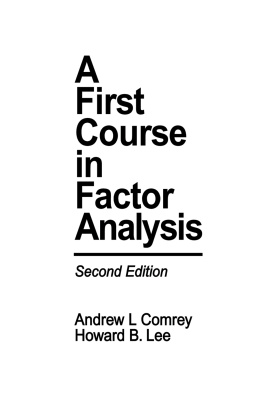
A FIRST COURSE IN FACTOR ANALYSIS
Second Edition
A FIRST COURSE IN FACTOR ANALYSIS
Second Edition
Andrew L. Comrey
University of California, Los Angeles
Howard B. Lee
California State University, Northridge

First Published by
Lawrence Erlbaum Associates, Inc., Publishers
365 Broadway
Hlilsdale, New Jersey 07642
Transferred to Digital Printing 2009 by Psychology Press
270 Madison Avenue, New York NY 10016
27 Church Road, Hove, East Sussex BN3 2FA
Copyright 1992 by Lawrence Erlbaum Associates, Inc.
All rights reserved. No part of the book may be reproduced in any form, by photostat, microform, retrieval system, or any other means, without the prior written permission of the publisher.
Library of Congress Cataloging-in-Publication Data
Comrey, Andrew Laurence.
A first course in factor analysis / by Andrew L. Comrey and Howard B. Lee. 2nd ed.
p. cm.
Includes bibliographical references and index.
ISBN 0805810625
1. Factor analysis. I. Lee, Howard B. (Howard Bing), 1949 II. Title.
QA278.5.C66 1992
519.5354dc20
922896
CIP
Publishers Note
The publisher has gone to great lengths to ensure the quality of this reprint but points out that some imperfections in the original may be apparent.
CONTENTS
It is perhaps presumptuous for a nonmathematician to undertake the writing of a textbook on a topic such as factor analysis. After teaching the course in factor analysis for many years, however, I feel that I have been able to develop a clear picture of what students need in the way of an introduction to the topic. Furthermore, although good books on factor analysis have been published in recent years, they tend to be either too difficult for the typical student or else not sufficiently oriented toward providing an understanding of the underlying rationale for the technique.
I have tried to develop a book that will serve the needs of talented but mathematically unsophisticated advanced undergraduates, graduate students, and research workers who wish to acquire a basic understanding of the principles upon which factor analysis rests so that they can correctly apply these methods in their own work and intelligently evaluate what others are doing with them. I have tried to pitch the book at a level that will be a challenge for such readers but not so difficult as to discourage them. On the assumption that the emphasis in such a beginning text should be on more fundamental topics, I have minimized the amount of attention given to certain complex controversial issues, and I have omitted many recent developments. I feel, therefore, that this book represents not a substitute for such excellent advanced works as those of Harman and Horst but rather an introduction to them. After mastering the contents of this book, the typical student will find it much easier to read these more advanced books as well as new material in such technical journals as Psychometrika.
Another reason for my writing this book was to present in one volume some of the things I have learned about factor analysis that are not treated by other authors. For example, I have developed the minimum residual method of factor extraction and also an analytic method of factor rotation. These methods have been applied in my own research as integral parts of an overall research strategy that has given me good empirical results. I want to share these and other techniques I have developed with fellow research workers in the hope that they too will find them useful. Finally, I have taken this opportunity to present some of my own philosophical views on the use of factor analytic methods in scientific research.
I have been influenced by many people in developing my own conceptions about factor analysis: by my teacher, J. P. Guilford; my friends and colleagues, H. H. Harman, R. B. Cattell, and H. F. Kaiser; and many others. I would like to acknowledge this debt. Students from two separate classes have used the manuscript as a text and have offered many helpful suggestions. Some of the people who have been most instrumental in bringing about changes in the manuscript itself are Peter Bentler, Lee Cooper, Ken Ford, Richard Harshman, Diana Solar, and Mike Vandeman. Last but not least, I am indebted to my wife, Barbara Sherman Comrey, for encouraging me to write the book and for her continued support.
Andrew L. Comrey
The first edition of this book (Comrey, 1973) was written prior to the rise in popularity of confirmatory factor analysis and structural equation modeling and the general availability of sophisticated computer programs to perform the intricate computations involved, e.g., LISREL and EQS. These newer methods have revolutionized factor analysis in the last few years so that any factor analysis textbook which ignores them is necessarily dated. The decision was made, therefore, to revise the original edition of this book to include at least an introduction to these newer methods. The mathematical basis of these newer methods is so complex and the topic is so extensive, however, that this book can only hope to provide the reader with a brief introduction to the topic and how it relates to more traditional factor analytic methods. Other parts of the original edition have been updated, newer material relating to the validation of the Comrey Personality Scales has been added, and the computer programs have been modifed and expanded in addition to making them available on convenient diskettes for ready transfer to readers computer facilities. Both authors of the current edition have worked on all parts of the book, but more responsibility for writing the material on confirmatory factor analysis and structural equation models lay with the second author. The other chapters were written primarily by the first author.
The authors want to thank many students in the first authors classes on factor analysis, anonymous reviewers, and Professor Stanley A. Mulaik, all of whom have offered helpful suggestions for improving the book. Programmer Paul Hoffman of the UCLA Office of Academic Computing helped update some of the computer programs for the latest version of the FORTRAN compiler. Programmer Eric Wu of Professor Peter Bentlers lab at UCLA helped adapt the programs for the IBM PC. In addition, the authors are especially endebted to Professor Peter M. Bentler for his critical reading of the chapters on confirmatory factor analysis and structural equation modeling. Dr. Bentler located several errors in the initial draft of the manuscript and made a number of very helpful editorial suggestions. Any errors and deficiencies that remain, however, are the sole responsibility of the authors.
Andrew L. Comrey
Howard B. Lee
Introduction
Discovering the nature of relationships between variables is a very important part of any scientific field. In the well-established sciences, the variables to be related are precisely defined and widely accepted by the scientific community as the important variables to study. The relationships of these variables with each other are frequently specified mathematically, and these mathematical relationships between variables in some cases are further organized into elaborate mathematical theories involving several interrelated variables. In the newer scientific fields the variables are less precisely defined, there is not so much agreement among scientists concerning what variables should be related to each other, and the nature of the relationships between variables is less clearly specified. Factor analysis represents a rapidly growing body of statistical methods that can be of great value in these less developed sciences. Factor analytic methods can help scientists to define their variables more precisely and decide what variables they should study and relate to each other in the attempt to develop their science to a higher level. Factor analytic methods can also help these scientists to gain a better understanding of the complex and poorly defined interrelationships among large numbers of imprecisely measured variables. The purpose of this book is to help the reader achieve some familiarity with these powerful methods of analysis.
Next page













